1996 PONTIAC GRAND-AM service
[x] Cancel search: servicePage 273 of 356
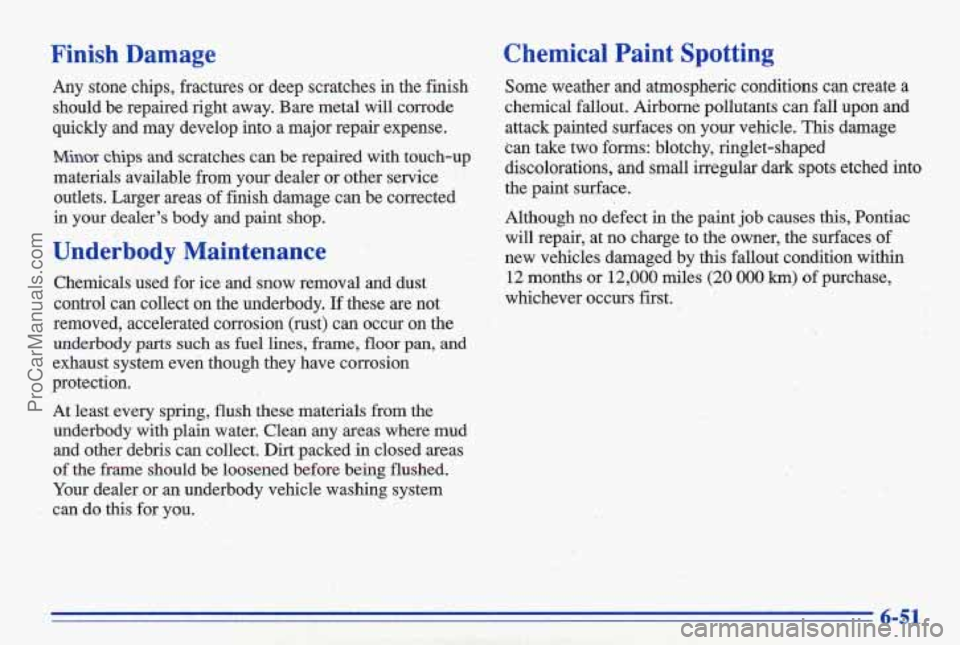
Finish Damage
Any stone chips, fractures or deep scratches in the finish
should be repaired.right away. Bare metal will corrode
quickly and may develop i-nto a major repairexpense.
Minor chips and scratches can be repaired with touch-up
materials available from your dealer or other service outlets. Larger areas of finish damage can be correcte'd
in your dealer's body and paint shop.
,Underbody Maintenance
Chemicals used for ice and snow removal and dust
control
can collect on the underbody. If these are not
removed, accelerated corrosion (rust) can occur on the
underbody parts such as fuel lines,-frame, floor pan, and
exhaust system even though they have corrosion
protection.
At least every spring, flush these materials from the underbody with plain water. Clean any areas where mud and other debris can collect.
Dirt packed in closed areas
of
the frame should be loosened before being flushed.
Your dealer or
an underbody vehicle washing system.
can do this for you.
Chemical Paint Spotting
Some weather and atmospheric conditions can create a
chemical fallout. Airborne pollutants can fall upon and
attack painted surfaces on your vehicle. This damage
%an take two forms: blotchy, ringlet-shaped
discolorations, and small irregular dark spots etched into
the paint surface.
Although no defect in the paint job causes this, Pontiac
will repair, at
no charge to the owner, the surfaces of
new vehicles damaged by this fallout condition within
12 months or 12,000 miles (20 000 km) of purchase,
whichever occurs first.
6-51
ProCarManuals.com
Page 275 of 356
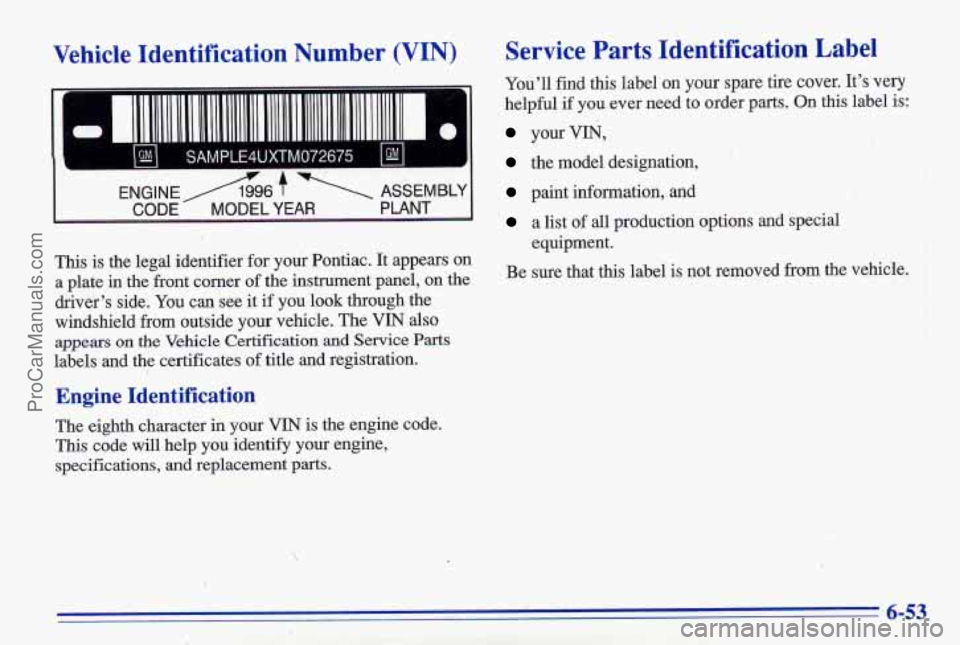
Vehicle Identification Number (VIN)
SAMPLE4UXTM072675 bl
ENGINEAG f ASSEMBLY
CODE MODEL YEAR PLANT
This is the legal identifier for your Pontiac. It appears on
a plate in the front corner of the instrument panel, on‘the
driver’s side.
You can see it if you look through the
windshield from outside your vehicle. The
VIN also
appears on the Vehicle Certification and Service Parts
labels and the certificates of title and registration.
Engine Identification
The eighth character in your VIN is the engine code.
This code
will help you identify your engine,
specifications,
and replacement parts.
Service Parts Identification Label
You’ll find this label on your spare tire cover. It’s very
helpful if you ever need to order parts. On this label is:
your VIN,
the model designation,
paint information, and
a list of all production options and special
Be sure that this label is not removed from the vehicle. equipment.
6-53
ProCarManuals.com
Page 279 of 356

Fuse
WIPER
02
,DR UNLK
ALARM
FOG/FTP
PRNDL
BR LK 2
AIR BAG
HORN
Usage
Windshield Wipers/Washers
Heated Oxygen Sensors Automatic
Door Unlock
Automatic Transaxle, Automatic
Door Unlock, Alarm Module
(Illuminated Entry, Warning
Chimes), TraGtion Telltale, Rear
Window Defogger, Remote
Keyless Entry
Fog Lamps
Instrument Cluster, Powertrain Computer, Park-Lock Solenoid,
Electronic
PRNDL
Door Locks
Air Bag-Power
Horn, Service Tool Power
Fuse Usage
INST Instrument Cluster
STOP
HAZ Stoplamps, Hazard Lamps,
Anti-Lock Brakes
PCM Powertrain Control Module
DR LK
1 Door Locks
INST
LPS Instrument Panel Lights, Fog
Lamps
RR DEF Rear Window Defogger
HDLP Headlamps, Daytime Running Lamps (Circuit Breaker)
Steering Wheel Controls (If Equipped)
Fuse Panel .. - / , . . , ;';,,;'.[ -: .f-, .-.;'.A, Li-v. I , , ~ I , , .,$! ::.
Your steering wheel radio controls are protected
by fuses. For service, contact your Pontiac
service department.
. ._ .,~ \. ~, ' ' ~ .j_ . ,:: :?<. , x:'. -.
6-57
ProCarManuals.com
Page 285 of 356
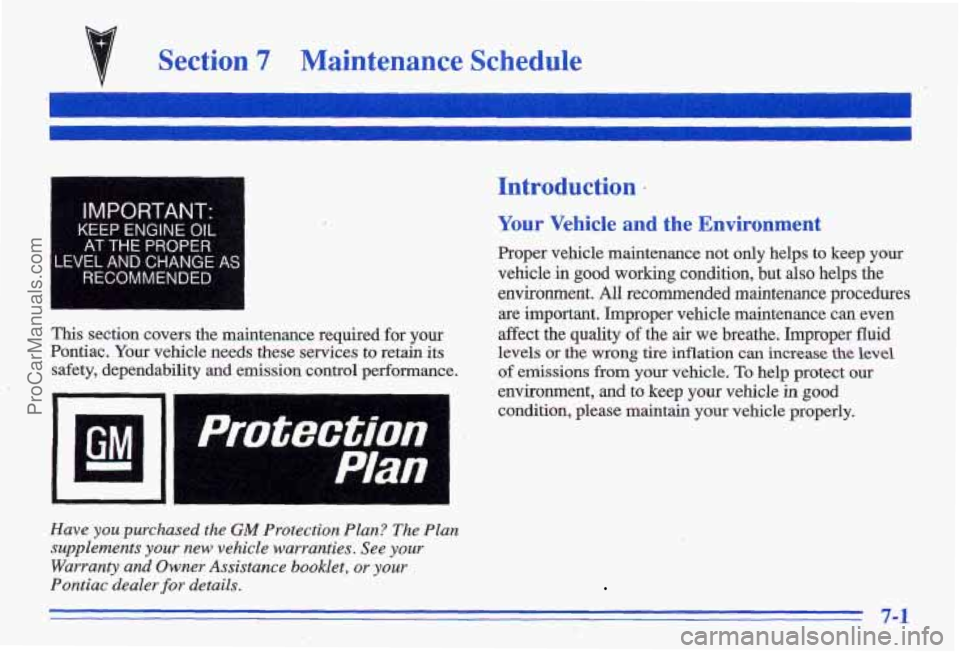
v Section 7 Maintenanc,e Schedule - -.
IMPORTANT-
KEEP ENGINE OIL
AT THE PROPER
.EVEL AND CHANGE AS
RECOMMENDED
Introduction
Your Vehicle and the Environment
Proper vewcle maintenance not only helps to keep your
vehicle in good working condition, but also helps the
environment. All recommended maintenance procedures
are important. Improper vehicle maintenance can even
~ This section covers the maintenance required for your affect the quality of the air we breathe. Improper fluid
Pontiac. Your vehicle needs
these services to retain its levels or the wrong tire inflation can increase the level
safety, dependability and emission control performance. of emissions from your vehicle. To help protect our
..
'. 2 ,
Have you purchased the GM Protection Plan? The Plan
supplements your new vehicle warranties. See your
Warranty and Owner Assistance booklet, or your
Pontiac dealer for details. .- ,! .- .. .. .. .. 1' . '>.. 3 , .. -. ., . -b . ' .: : I .6.
7-1
ProCarManuals.com
Page 286 of 356
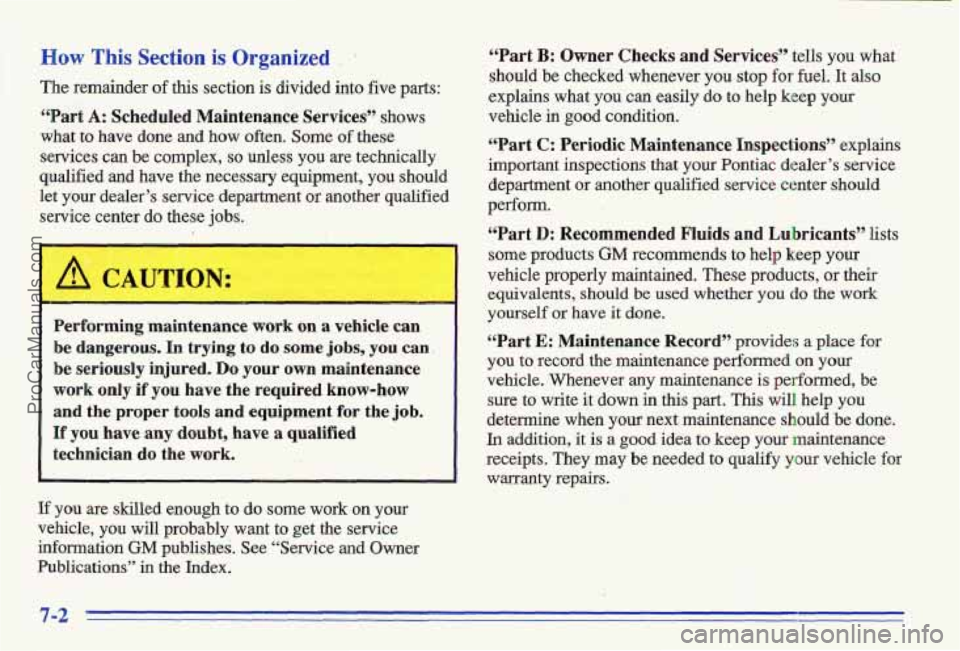
How This S
The remainder
lection is Organized , . LLPart B: Owner Checks and Services” tells you what
of this section is divided into five parts: should be checked whenever you stop for fuel. It also
explains what you can easily do to help keep
your
“Part A: Scheduled Maintenance Services” shows vehicle in good condition.
what to have done
and how often. Some ‘of these
services
can be complex, so unless you are technically
let your dealer’s service department or another qualified pefiom.
service center do these jobs.
LLPart C: Periodic Maintenance Inspections” explains
important inspections that your Pontiac dealer’s service
qualified
and have the You department or mother qualified semice center should
‘(Part D: Recommended Fluids and Lubricants” lists
some products GM recommends to help keep your
vehicle properly maintained. These products, or their equivalents,
should be used whether you do the work
yourself or have it done.
Performing maintenance work on a vehicle can
be dangerous. In trying to
do some jobs, YOU can. “Part E: Maintenance Record” provides a place for
be seriously injured. Do your own maintenance you to record the maintenance performed on your
work only if you have the required know-how vehicle. ‘Whenever any maintenance is performed, be
sure to write it down
in this part. This will help you and the proper tools and equipment for the job. determine when your next maintenance should be done.
If you have any doubt, have a qualified In addition, it is a good idea to keep your maintenance
technician do the work. receipts. They may be needed to.qualify your vehicle for
1’ -
warranty repairs.
If you are skilled enough to do some work on your
vehicle, you will probably want to get the service information
GM publishes. See “Service and Owner
Publications”
in the Index.
7-2
ProCarManuals.com
Page 287 of 356
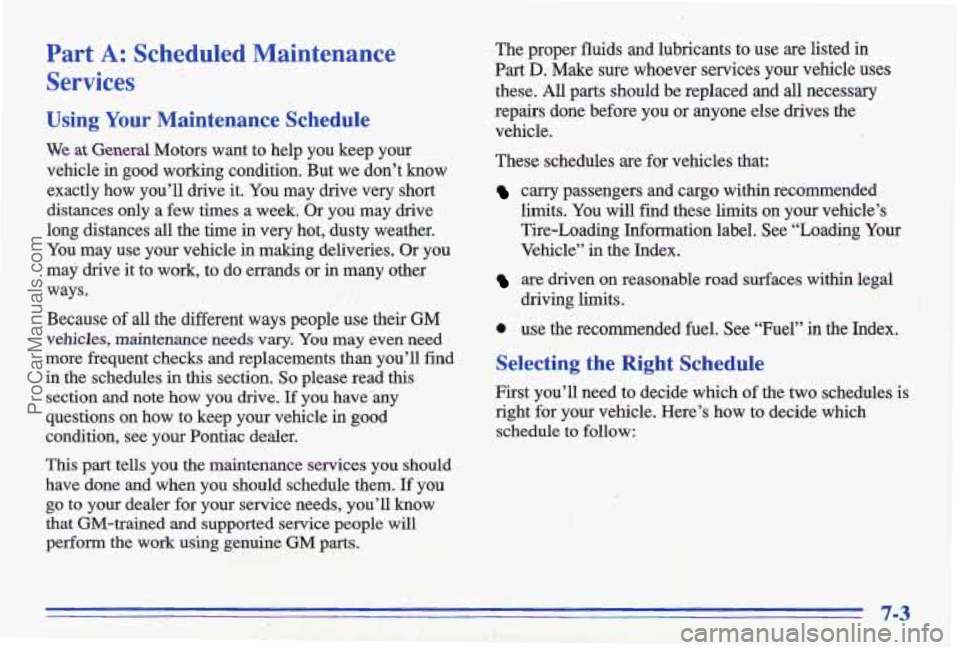
Part A: Scheduled Maintenance
Services
Using Your Maintenance Schedule
We at General Motors want to help you keep your
vehicle in good working condition. But we don’t
know
exactly how you’ll drive it. You may drive very short
distances only a
few times a week. Or you may drive
long distances all the time
in very hot, dusty weather.
You may use your vehicle in making deliveries. Or you
may drive it to work, to do errands or in many other
ways.
Because of all the different ways people use their GM
vehicles, maintenance needs vary. You may. even .need
more frequent checks and replacements than you’ll find
in the schedules in this section.
So please read this
section and note how you drive.
If you have‘any
questions on how to keep your vehicle in good condition, see your Pontiac dealer.
This
part tells you the maintenance services you should
have done and when you should schedule them.
If you
go to your dealer for your service needs, you’ll know
that GM-trained and supported service people will perform the work using genuine
GM parts. The proper fluids and lubricants to use
are listed in
Part D. Make sure whoever services.your vehicle uses
these. All parts should be replaced and all necessary
repairs done before you or anyone else drives the
vehicle.
These schedules
are for vehicles that:
carry passengers and cargo within recommended
limits. You will find these limits on your vehicle’s
Tire-Loading Information label. See “Loading
Your
Vehicle” in th’e Index.
are driven on reasonable road surfaces within legal
0 use the recommended fuel. See “Fuel” in the Index.
Selecting the Right Schedule
First you’ll need to decide which of the two schedules is
right for your vehicle. Here’s how to decide which schedule to follow: driving limits.
7-3
ProCarManuals.com
Page 288 of 356
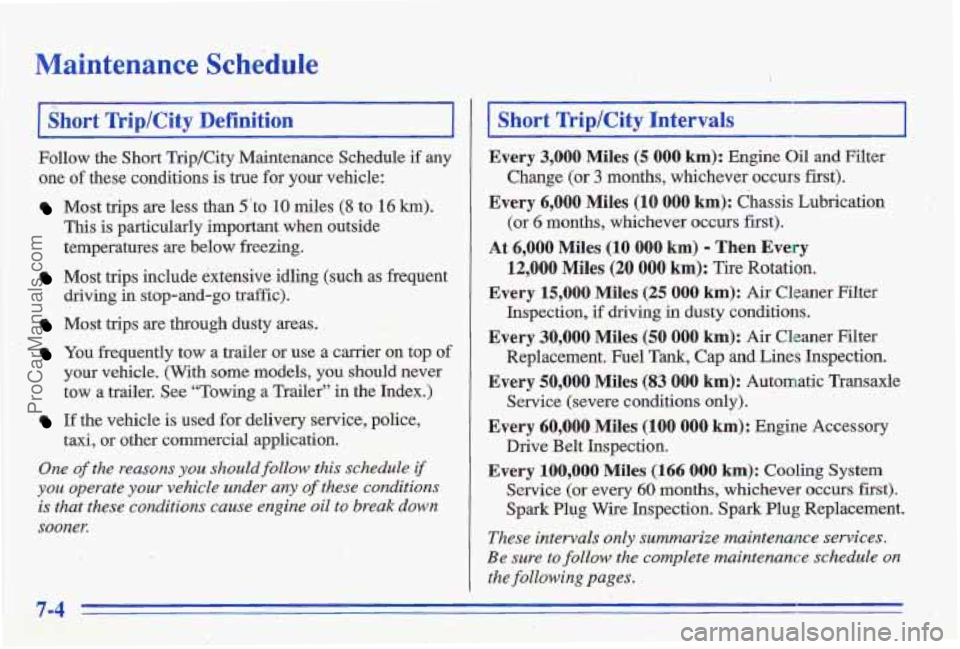
Maintenance Schedule
~~~~ .
Short Ikip/Cit"""'
Follow the Short Trip/City Maintenance Schedule if any
one of these. conditions is true for your vehicle:
Most trips are less than 5'to 10 miles (8 to 16 km).
This is particularly important when outside
temperatures are below freezing.
Most trips include extensive idling (such as frequent
driving in stop-and-go traffic).
Most trips are through dusty areas.
You frequently tow a trailer or use a carrier on top of
your vehicle. (With some models, you should never
tow a trailer. See
"Towing a Trailer" in the Index.)
taxi, or other commercial application.
If the vehicle is used for delivery service, police,
One of the reasons you should follow this schedule if
you operate your vehicle under any of these conditions
is that these conditions cause engine oil to break down
sooner.
I,
t
~~
Short Trip/City Intervals r
Every 3,000 Miles (5 000 km): Engine Oil and Filter
Change
(or 3 months, whichever occurs first).
Every 6,000 Miles (10 000 km): Chassis Lubrication
(or
6 months, whichever occurs first).
At 6,000 Miles (10 00'0 km), - Then Every
12,000 Miles (20 000 km): Tire Rotation.
Every 15,000 Miks (25 000 km): Air Cleaner Filter
Inspection,
if driving in dusty conditions.
Every 30,000 Miles (50 000 km): Air Cleaner Filter
Replacement. Fuel
Tank, Cap and.Lines Inspection.
Every 50,000 Miles (83 000 km): Automatic Transaxle
Service (severe conditions only).
Every 60,000 Miles (I00 000 b): Engine Accessory
D'rive Belt Inspection.
Every 100,000 Miles (166 000 km): Cooling System
Service (or every
60 months, whichever occws first).
Spark Plyg Wire Inspection. Spark Plug Replacement.
These intewals only summarize maintenance services.
Be sure to
follow the complete maintenance schedule on
the following pages. . L . . .:-
ProCarManuals.com
Page 289 of 356
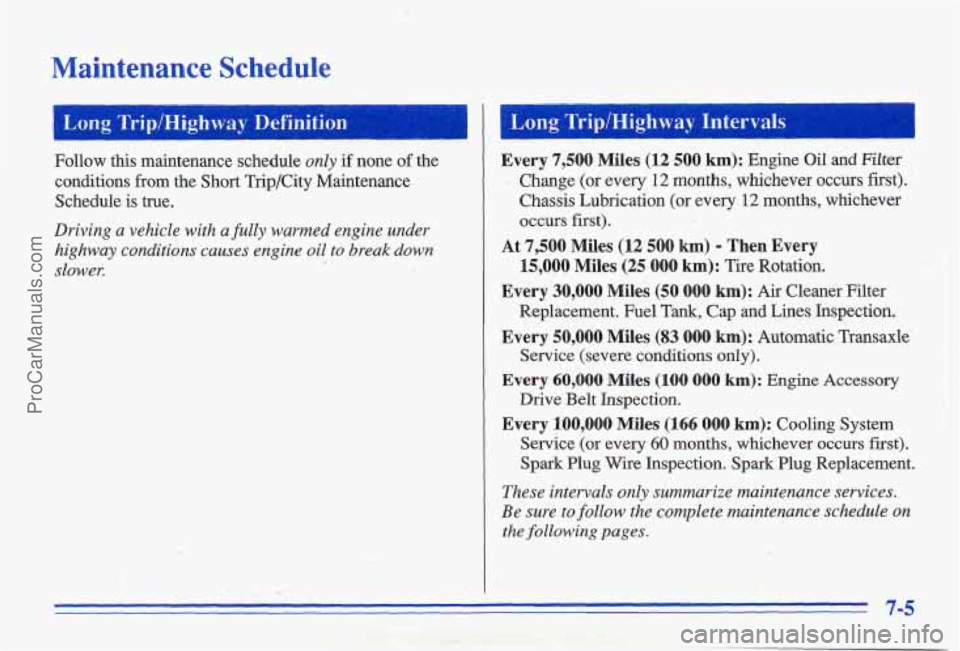
Maintenance Schedule
Long Trip/Highway Definition Long TriplHighway Intervals ~~ ~ ~~ ~
Follow this maintenance schedule only if none of the
conditions from the Short Trip/City Maintenance Schedule
is true.
Driving a vehicle with a fully warmed engine under
highway conditions causes engine oil
to break down
slower. I
Every 7,500 Miles (12 500 km): Engine Oil and Filter
Change (or every 12 months, whichever occurs first).
Chassis Lubrication
(or every 12 months, whichever
occurs first).
At 7,500 Miles (12 500 km) - Then Every
15,000 Miles (25 000 km): Tire Rotation.
Every 30,000 Miles (50 bo0 km): Air Cleaner Filter
Replacement. Fuel Tank, Cap and Lines Inspection.
Every 50,000 Miles (83 000 km): Automatic Transaxle’
Service (severe conditions only).
Every 60,000 Miles (100 000 km): Engine Accessory
Drive Belt Inspection.
Every 100,000 Miles (166 000 km): Cooling System
Service (or every
60 months, whichever occurs first).
Spark Plug Wire Inspection. Spark Plug Replacement.
These intervals only summarize maintenance services.
Be sure to
follow the complete maintenance schedule on
the following pages.
,. . ~ - . .._.. .
7-5
ProCarManuals.com